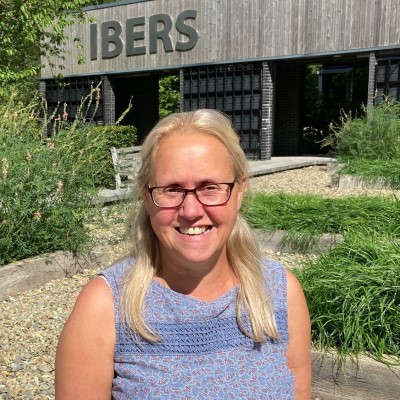CIEL | Meet the Scientist
Dr Farina Khattak
Commercial Research Scientist/Study Director

As a poultry nutritionist, Farina is extensively involved in planning, executing, analysing and reporting commercial nutritional projects. Her studies range from proof of concept to novel in-depth investigations to unveil the mode of action of the novel products tested. Studies also include measuring greenhouse gas emissions (CO2, NH3, N2O and CH4).
What project/s are you currently working on?
Being a poultry nutritionist, my current research focuses on four primary areas:
- Nutritional evaluation of feedstuffs to expand and improve poultry feed resources
- Exploring the role of nutritional interventions to improve production, gut health, carcass quality, and welfare indicators such as footpad and hock scores, feather pecking etc., in broilers, laying hens and turkeys
- Advancing the understanding of the application of exogenous feed additives (prebiotics, probiotics and synbiotics) to improve nutrient utilisation, modulate gut health, reduce feed cost and minimise nutrients excretion into the environment
- Use of chicken infection models to investigate host-pathogen interactions where animals will be exposed to pathogens such as Eimeria spp or Campylobacter spp., or in some cases, animals may be exposed to re-used litter.
What capability are you drawing on to deliver the research?
The in-vivo research is carried out at the SRUC’s state-of-the-art Allermuir Avian Innovation and Skills Centre (AISC) at the Easter Bush Campus near Edinburgh, built in partnership with CIEL thanks to the support of Innovate UK and the Scottish Funding Council’s Financial Transactions Programme.
The Allermuir AISC is UK’s largest poultry facility dedicated to improving avian nutrition, health and welfare. Here we design, manage and deliver research in poultry science to an internationally-recognised high standard, from concept through to robust demonstration of an application to meet our industrial and academic partners’ poultry research requirements.
Facilities include a near-commercial scale brooder facility, with flexible accommodation for up to 144 floor pens to accamodate nearly 6000 birds in total, complemented by an additional multi-purpose poultry house comprising multiple small-scale animal rooms, Home Office approved raised-floor units, enriched housing layer facility for up to 1344 hens, and flexible large floor pen facilities for ~800 birds.
This capability allow us to run studies to investigate production and efficacy, behaviour and welfare, product quality and safety, gut and skeletal health (including microbes, food safety, antimicrobial resistance profiling, keel bone assessment of live birds, pain assessment and gait analysis, disease challenge models, meat myopathies) and estimation of greenhouse gas/carbon footprint determination in broilers, layers and turkeys.
The strength of our unit lies in the diversified and highly motivated research-driven team comprised of nutritionists, microbiologists and animal behaviour and welfare scientists.
What would be your ideal research project assuming no barriers to resources?
This is a tricky question to answer as my wish list is too big! I’ve been working with zoonotic pathogens, especially Campylobacter, for more than a decade now. I often ask myself if judging the impact of Campylobacteriosis via Campylobacter spp. counts the appropriate criteria to measure its transmission to a human? I would like to run a series of trials to identify factors associated with Campylobacter detection in zoonotic etiopathogenesis to answer my question.
How did you arrive at doing what you do now?
I grew up in Pakistan. At times (4 decades ago), Animal Sciences was the domain of men. I was the first (but thankfully not the last) female who was enrolled in the Department of Animal Husbandry.
I completed my BSc (Hons) in Animal Husbandry and MSc (Hons) in Poultry Nutrition, both with a distinction and first position and thus was awarded a merit scholarship to do my PhD abroad. I then did my PhD in Poultry Nutrition at the University of Aberdeen. That is where my connection with SRUC began as my first supervisor (my best mentor ever) was from SRUC.
After completing my PhD in 1997, I headed home to Pakistan and joined the Allama Iqbal Open University (AIOU) as a lecturer, where I launched the MSc (Hons) programme in Livestock Management through distance learning.
In 2003, my love for poultry led me to join the University of Veterinary and Animal Sciences (UVAS) in Lahore where I worked as an Associate Professor and was involved in extensive teaching and research in the Department of Poultry Science.
In 2008, I returned to Scotland to do a post-doctoral research fellowship at SRUC’s Avian Science and Research Centre at Ayr and I have never left SRUC/Scotland since then. I have been fortunate to learn and work with the best poultry scientists in SRUC and had the unique opportunity to work in various SRUC poultry facilities such as Craibstone (Aberdeen) and Auchincruive (Ayr) before moving with the unit to our new state of art poultry facility, Allermiur AISC.
Currently, in my role as a Commercial Study Director at the SRUC Monogastric Science Research Centre, I am extensively involved in planning, executing, analysing and reporting commercial nutritional projects. I work closely with several national and international poultry feed ingredient companies and institutions. The majority of my projects are funded through industry research grants.
Most of your work is commercially sensitive, but what are the most exciting products/product types you have recently been working with?
Yes, and this is the part of my research that I enjoy the most. Working with commercially sensitive products/concepts means that every trial is unique and thus gives me an opportunity to learn something new every day. Tighter regulatory requirements and pressure on the industry to meet sustainable production goals and to address consumer demands to produce safe and healthy poultry & poultry products forces researchers to broaden their portfolio to target multiple objectives concurrently. With changing needs of the poultry industry, I see my current role as a poultry nutrition ‘octopus’, with my tentacles in different areas of poultry research (zootechincal performance, gut microbiome, environmental footprinting, carcass quality, meat myopathies and animal welfare etc.).
Currently, my research focuses on refining our disease challenge models that allow us to develop and test nutritional strategies to substitute antibiotics that can maintain poultry health and productivity without triggering antimicrobial resistance and thus allow safe food production.
Working alongside our microbiological experts is very exciting and promising. We have in-vitro protocols in place to run quantitative and qualitative analyses of the microbiota through sequencing in the different treatment groups, allowing us to understand whether microbiota and/or single taxonomical groups changed in response to the Treatment.
Our latest industry-endorsed egg quality machine allows us to study internal and external egg quality. It will enable us to understand if novel test treatments impacted egg quality parameters that are important to hatchery producers and retailers.
Working alongside our animal behaviour and welfare team means that we have the ability to assess different breeds (both slow and fast-growing) and determine if the nutritional interventions would impact their keel bone health, gait scoring, leg health, meat myopathies (wooden breast, white striping, spaghetti meat and meat pH) and of course, animal performance.
Finally, with the recent shift to reduce the environmental impact of poultry farming, my current studies also include measuring greenhouse gas emissions (CO2, NH3, N2O and CH4).
Find out more about the Allermuir AISC, including taking a virtual tour.







